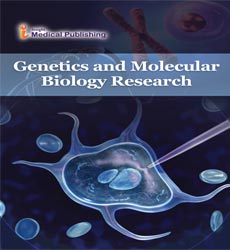A Short Note on Population and Medical Genetics
Department of Genetics, Osmania Medical College Hyderabad, India
- Corresponding Author:
- Narahari M
Department of Genetics
Osmania Medical College Hyderabad, India
E-mail: narahari.m@gmail.com
Received Date: July 10, 2021; Accepted Date: July 23, 2021; Published Date: July 30, 2021
Citation: Narahari M (2021) A Short Note on Population and Medical Genetics. Genet Mol Biol Res Vol No: 5 Iss No:4:54
Copyright: © 2021 Narahari M. This is an open-access article distributed under the terms of the Creative Commons Attribution License, which permits unrestricted use, distribution, and reproduction in any medium, provided the original author and source are credited.
Abstract
Rare genetic disorders problems are as of now at the centre of attention because of the raised number of various conditions and critical all out number of influenced patients. The investigation of these issues is incredibly useful for the clarification of physiological cycles related with complex issues. Disengaged populaces are instrumental for the investigation of hereditary problems, thinking about their homogeneity and high extent of influenced patients in a little geographic region. These good conditions lead to the formation of another discipline, known as "populace clinical hereditary qualities
Keywords
Genes; Homogenecity; Population
Population Medical Genetics Risk
Human hereditary variety has for quite some time been contemplated both to see what hereditary variety means for hazard of infection and gather parts of human transformative history. In this article, we survey authentic and contemporary perspectives on human hereditary variety, the uncommon and normal changes involved in human infection powerlessness, and the importance of hereditary variety to customized medication. To begin with, we portray the advancement of contemplated variety through the twentieth century and through more current investigations including genome-wide affiliation consider (GWAS) and cutting edge sequencing. We present a few models, for example, sickle cell iron deficiency and Tay–Sachs sickness that are brought about by uncommon transformations and are more continuous in certain topographical populaces, and normal therapy reactions that are brought about by normal variations, for example, hepatitis C disease. We finish up with remarks about the proceeded with importance of human hereditary variety in clinical hereditary qualities and customized medication all the more by and large We all contrast at the level of our DNA succession, and geneticists fixate on attempting to comprehend the meaning of this hereditary variet [1-3]. This is a significant objective, as by understanding human hereditary variety we can find out about the transformative history of our species, where we have come from, and maybe where we are going. All the more basically, understanding human hereditary variety is vital for understanding the science of our illnesses of different sorts, from the hereditarily more easy to more unpredictable, and how we react to therapy at both the populace and individual levels The fruitful consummation of the Human Genome Project in 2003 was the first in a progression of huge worldwide public endeavors that started to move the field of clinical hereditary qualities from simply illustrative documentation of patients' actual provisions combined with relentless individually assessment of a little subset of their qualities for possibly pathogenic changes. For instance, the International HapMap Project's assortment of millions of genotypes from four worldwide populaces was fundamental to the quest for innate changes in qualities that add to infection by giving the stage to alleged "genome-wide affiliation examines" (GWAS). GWAS enabled us to proficiently and extensively examine hereditary variations that are normal in a populace and recognize those that show up more usually in patients with a given sickness than they do in controls without the infection. Such variations can in some cases give pieces of information to the hereditary premise of human infection and analysts have benefited from our worked on comprehension of populace history to recognize sickness causing qualities Along the way, propels in our comprehension of examples of human hereditary variety have additionally educated our view regarding the historical backdrop of present day human populaces. Our translation of the logical information, notwithstanding, has been affected by the continually developing sociopolitical milieu. During the early piece of the twentieth century, two ways of thinking arose on what regular determination meant for the recurrence and dispersion of hereditary variety [4,5].
References
- Aidoo M, Terlouw DJ, Kolczak MS, McElroy PD, ter Kuile FO, et al. (2002). Protective effects of the sickle cell gene against malaria morbidity and mortality. Lancet 359: 1311-1312
- Alfonso-Sanchez MA, Perez-Miranda AM, Garcia-Obregon S, Pena JA (2010). An evolutionary approach to the high frequency of the ΔF508 CFTR mutation in European populations. Med Hypotheses 74: 989-992.
- Ashley-Koch A, Yang Q, Olney RS (2000). Sickle hemoglobin (HbS) allele and sickle cell disease: A HuGE review. Am J Epidemiol 151: 839-845.
- Bertranpetit J, Calafell F (1996). Genetic and geographical variability in cystic fibrosis: Evolutionary considerations. Ciba Found Symp 197: 97-114.
- Bray SM, Mulle JG, Dodd AF, Pulver AE, Wooding S, Warren ST (2010). Signatures of founder effects, admixture, and selection in the Ashkenazi Jewish population. Proc Natl Acad Sci 107: 16222-16227.
Open Access Journals
- Aquaculture & Veterinary Science
- Chemistry & Chemical Sciences
- Clinical Sciences
- Engineering
- General Science
- Genetics & Molecular Biology
- Health Care & Nursing
- Immunology & Microbiology
- Materials Science
- Mathematics & Physics
- Medical Sciences
- Neurology & Psychiatry
- Oncology & Cancer Science
- Pharmaceutical Sciences
